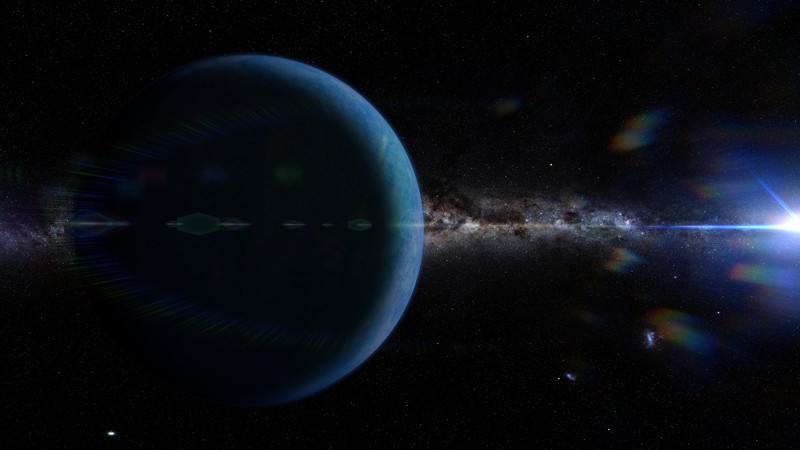Planet Nine is dead; long live Planet Nine? For some years, scientists have debated the existence of an unseen planet at least five times the mass of Earth in the outer reaches of the Solar System. Now, the hypothesis has been dealt a blow by a new analysis of distant, icy objects, which questions the evidence that they are under the gravitational pull of a huge planet.
The findings do not rule out the possibility of a ninth planet orbiting the Sun, and astronomers say more data will be needed to put the debate to rest.
The presence of Planet Nine was proposed1 in 2016, when astronomers Mike Brown and Konstantin Batygin at the California Institute of Technology in Pasadena observed that the orbits of six trans-Neptunian objects (TNOs) — part of the Kuiper belt, a collection of small bodies orbiting the Sun beyond Neptune — seemed to be clustered together.
This clustering, they said, had to be due to the gravitational influence of a huge planet hiding somewhere in the outer Solar System, at least 400 times as far from the Sun as Earth, or around 10 times as far as the most famous TNO, the dwarf planet Pluto. If proved to exist, the distant world would be a major discovery — a giant beyond Neptune that would unquestionably be classed as a planet.
But not all astronomers were convinced. Other surveys cast doubt on whether TNOs were in fact clustered — or whether they merely appeared to be, because researchers had conducted detailed observations in only certain directions.
A team led by Kevin Napier, a physicist at the University of Michigan in Ann Arbor, has now taken this analysis further. Combining 3 surveys to examine the orbits of 14 ‘extreme’ TNOs (ETNOs) — those orbiting far beyond Neptune — the researchers found that the objects’ orbits could be explained without the presence of a nearby planet. After accounting for selection bias — the fact that researchers have observed only a small portion of the outer Solar System — the data suggest that ETNOs are uniformly distributed across the sky.
“This is the first meta-analysis of all three of the most productive ETNO-discovery surveys,” says Napier. The team’s findings2 were posted on the preprint server arXiv on 10 February.
Horses, not zebras
To investigate whether the objects were truly clustered, Napier’s team built a computer model simulating ten billion evenly distributed ETNOs in the outer Solar System, and then calculated the chances that observing a small sample of these would produce results matching existing observations. The team concluded that there is no reason to think that ETNOs are not uniformly distributed, and that it’s possible that observed objects only seem to be clustered because of selection bias. “That doesn’t mean that Planet Nine isn’t there, but it’s not necessary to explain the data,” says Napier. “You could fit this data with clustered ETNOs as well — but if you hear hoofbeats, you should think horses, not zebras.”
Brown, however, disagrees. “I plotted all their data on top of our old paper, and you just simply look at it, and it’s very clustered,” he says. “There’s actually strong evidence for Planet Nine in their data.” He points out that the paper does not include the six TNOs that he and Batygin used in their original research. He also argues that the researchers are “mixing dirt in with their ice cream”, because their analysis considers objects whose orbits might be affected by their proximity to Neptune.
Napier says the team didn’t include Brown and Batygin’s original six objects in its analysis because not enough data are available on the surveys that found them earlier this century. “We need to know when and where the telescope pointed, and how faint of an object the telescope was able to detect,” he says. “In the past, surveys did not tend to do that.”
Samantha Lawler, an astronomer at the University of Regina in Canada who worked on the Outer Solar System Origins Survey — one of the surveys that Napier’s team used in its analysis — agrees with the team’s conclusions, arguing that there is no need for Planet Nine when the simpler explanation of selection bias accounts for the data.
“There is no evidence for any sort of clustering in the orbits of these distant TNOs, they’re consistent with being uniformly distributed,” she says. “I can’t say that Planet Nine is dead, but I can say there’s no evidence for it.”
Thousands more objects
Lawler says new surveys of the outer Solar System are needed to look for any other evidence of clustering. One of the best chances will come from the Vera C. Rubin Observatory in Chile, which will begin a ten-year survey of the sky in 2022.
“They’re going to detect thousands more Kuiper belt objects,” says Lawler. “I think we’ve really done all that we can with the data we currently have.”
Even if it turns out Planet Nine isn’t there, Lawler says, it has sparked a lot of useful interest in the outer Solar System from astronomers. “The theory of Planet Nine has been fantastic for the study of the Kuiper belt,” she says.
"world" - Google News
February 20, 2021 at 12:19AM
https://ift.tt/3qxwoeq
No sign of Planet Nine? Trail runs cold for hypothetical world - Nature.com
"world" - Google News
https://ift.tt/3d80zBJ
https://ift.tt/2WkdbyX
Bagikan Berita Ini















0 Response to "No sign of Planet Nine? Trail runs cold for hypothetical world - Nature.com"
Post a Comment